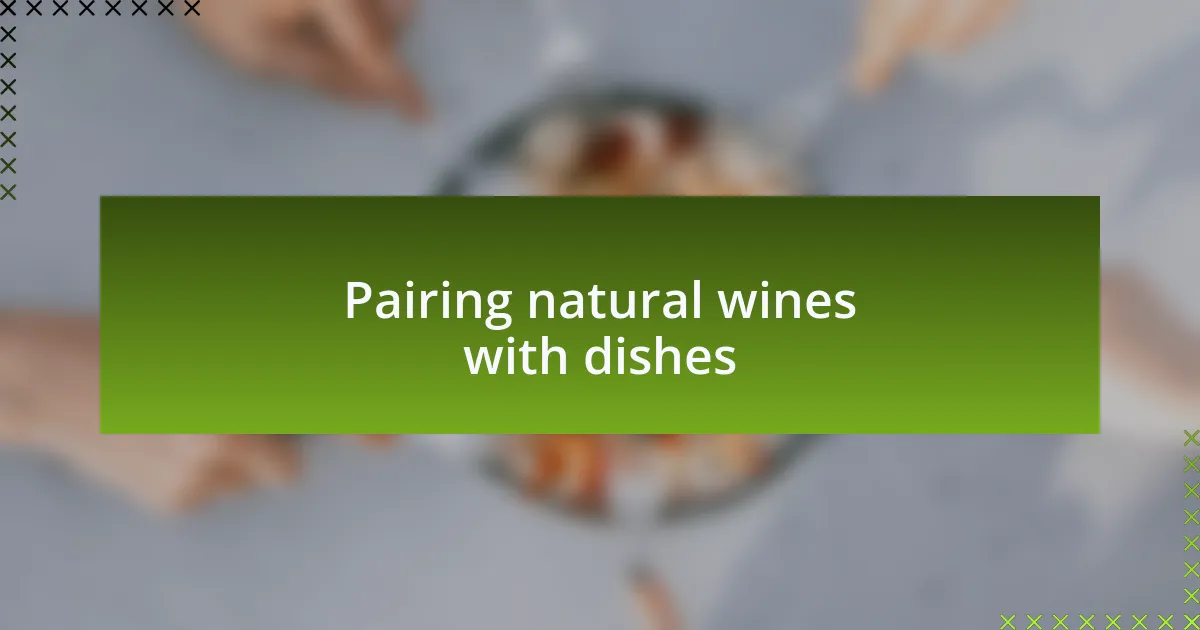Key takeaways:
- Natural wines emphasize minimal intervention, organic and biodynamic practices, and showcase unique flavors from their terroir due to wild yeast fermentation.
- High-quality natural wines exhibit vibrant acidity and earthy “funk,” enhancing their character and creating memorable tasting experiences.
- Food pairing with natural wines elevates the dining experience, with combinations like biodynamic Chenin Blanc and herb-crusted chicken creating magical flavors.
- Serving tips for natural wines include decanting reds for aeration, serving whites and oranges slightly chilled, and using stemless glasses to enhance the drinking experience.

Understanding natural wines
Natural wines are produced with minimal intervention, emphasizing organic and biodynamic farming practices. I remember my first sip of a natural wine; it was unlike anything I’d experienced before. That taste of the vineyard’s terroir and the vibrant, unfiltered quality made me wonder—how can something so simple create such depth?
The philosophy behind natural wine revolves around a commitment to purity. Winemakers often allow wild yeasts to ferment the grapes, resulting in unique flavors and aromas that tell a story of their origin. For me, each bottle feels like a conversation with the land, and that’s a connection I deeply cherish; it makes every glass feel special.
Understanding natural wines requires an appreciation for their unpredictability and variability, which is both exciting and daunting. Have you ever noticed how a bottle can surprise you with flavors that shift from sip to sip? I’ve found that this element of surprise keeps me coming back for more explorations, as every tasting becomes an adventure.

Characteristics of high-quality natural wines
High-quality natural wines often showcase a sense of place, or terroir, that is hard to find in conventional wines. I once enjoyed a robust red from an organic vineyard in the Loire Valley, and the flavors transported me straight to the sun-drenched hillsides. Isn’t it remarkable how a complex blend of minerals and climate can shape the personality of a wine?
One characteristic that stands out to me is the vibrant acidity often found in these wines. It’s refreshing and invigorating, creating a balance that enhances the overall experience. I vividly recall a sparkling orange wine that danced on my palate, leaving me eager for another sip. How can something so naturally simple feel so alive?
Lastly, the presence of funk—often described as earthy or even slightly wild—is a hallmark of many high-quality natural wines. This isn’t a flaw; rather, it’s an expression of the unique fermentation process. I remember sharing a bottle with friends where the aroma was undeniably unique, sparking discussions about flavor profiles and our experiences. Have you ever found yourself captivated by a wine’s character so much that it lingers in your memory? That’s the kind of magic natural wines can unfold.

Pairing natural wines with dishes
Pairing natural wines with dishes is truly an art form that I relish discovering. I recall a delightful dinner where I served a biodynamic Chenin Blanc alongside a herb-crusted chicken. The wine’s bright acidity perfectly cut through the richness of the dish, elevating the experience to something magical. Have you ever tasted a pairing that made you pause and appreciate each bite and sip? It’s moments like these that affirm why natural wines are such an exciting choice for food.
When venturing into the world of reds, I find that lighter, fruity natural wines really shine with charcuterie boards. I once enjoyed a juicy Grenache that interacted beautifully with a selection of cured meats and tangy cheeses. The way the flavors danced together left an imprint on my palate. It’s fascinating how certain wines can complement and enhance the nuances of each ingredient. Have you ever noticed how a specific wine can breathe new life into a simple spread?
Lastly, I think about red wines with earthier notes, such as a natural Pinot Noir, which works wonders with roasted vegetables. I remember a cozy evening where this combination provided a comforting balance of flavors. The wine’s earthiness mirrored the dish’s roasted profile, creating a harmonious connection that lingered long after the last bite. Isn’t it captivating when food and wine create a dialogue of tastes? That’s the joy of exploring natural wines with thoughtfully chosen dishes.

Recommendations for serving natural wines
When it comes to serving natural wines, I always recommend decanting them, especially for the reds. I remember a time I poured a rustic Cabernet Franc straight from the bottle; it felt a bit tight and closed off initially. After an hour in a decanter, however, the wine blossomed beautifully, revealing its complex notes of bell pepper and blackcurrant. Have you ever experienced the transformation that a little air can bring to a wine? It’s a small step that can elevate the overall tasting experience.
Temperature is another crucial aspect that I cannot stress enough. Natural wines, particularly whites and oranges, often perform best when served slightly chilled. I once served a lively Pet-Nat at a gathering and noticed how the cool temperature brought out vibrant fruit flavors that were otherwise hidden. It was fascinating to observe how temperature shifted the perception of a wine. Have you thought about how serving temperature could be influencing your home dining experiences?
Lastly, glassware plays an essential role in how we enjoy natural wines. I prefer using stemless glasses for natural wines because they create a relaxed atmosphere while allowing friends to enjoy the intimate experience of swirling and savoring. At a recent dinner party, I chose this option for an elegant yet approachable feel, and it made sharing stories over wine even more memorable. Isn’t it amazing how the choice of glass can impact not just the wine but the entire occasion?